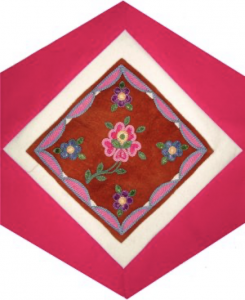South Slavey

The Block
Flora (Minoza) Lefoin, of the Deh Gah Gotie First Nation, used natural materials to create the South Slavey block. The background is a piece of traditionally smoked and tanned moose hide. Vividly coloured and tightly twisted moose hair forms the scalloped border and outlines each flower. The interior portion of the petals is embellished with flattened, dyed porcupine quills. These were the customary materials used before the women were able to obtain beads through trading. Slavey clothing was distinctly more decorative than other Athapaskan tribes. To this day, the Dene women are known for their beautiful beadwork and silk embroidery. The block pays tribute to the proud South Slavey people and their heritage.
Cultural Profile
The South Slavey are located in the Deh Cho region, along the Mackenzie River to the west of Great Slave Lake. Their mother tongue is classified under the Athapaskan linguistic family. Their neighbours in the larger area known as Denendeh, meaning “the Creator’s Spirit flows through this Land,” include four other Dene peoples: North Slavey, Gwich’in, Chipewyan and Dogrib. The Dene have lived for millennia in Canada’s western subarctic region. Their respect and knowledge of this land, passed orally from generation to generation, has ensured their survival in this harsh northern environment.
Hunting was a vital skill, and moose the primary quarry of the South Slavey. Small game animals, fish and berries augmented their diet. Traditional foods, such as dried fish and meat, are still regularly prepared. During the spring, summer and fall they travelled in small groups of extended family members setting up hunting camps. During the winter months several of these groups would come together to set up more permanent living quarters at well known locations. The main modes of transportation were birchbark or spruce canoes, toboggans and snowshoes.
The social organization of extended family groups allowed for a caring environment of social control. Values and mores were instilled in the young through a longstanding oral tradition of stories, myths and legends that often emphasized the need for developing strong skills and contributing to the community as a whole. Efforts have been made to preserve in print the legends and stories of the Elders, as well as their distinct South Slavey language. The social landscape changed with the arrival of the Hudson’s Bay Company and missionaries. Trapping became an economic endeavour, while traditional camps evolved into more permanent settlements.
The tourism industry provides the South Slavey people with an opportunity to sell their unique and beautiful handcrafts that showcase their talent for moosehair tufting, porcupine quill embroidery and beadwork. Many spend their winters trapping and the summers fighting forest fires.
Sponsor: Carmen and Jack Hunting and Eleanor Sides, in memoriam Mary Higginson
